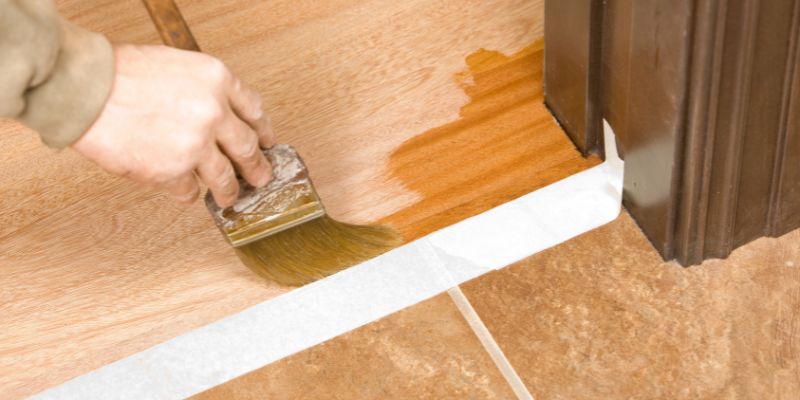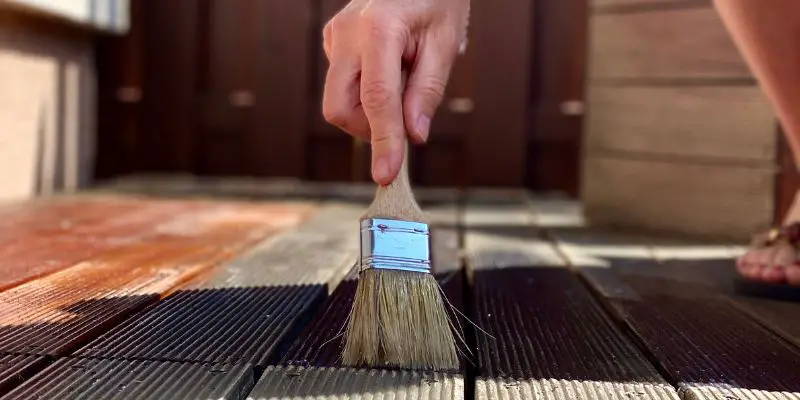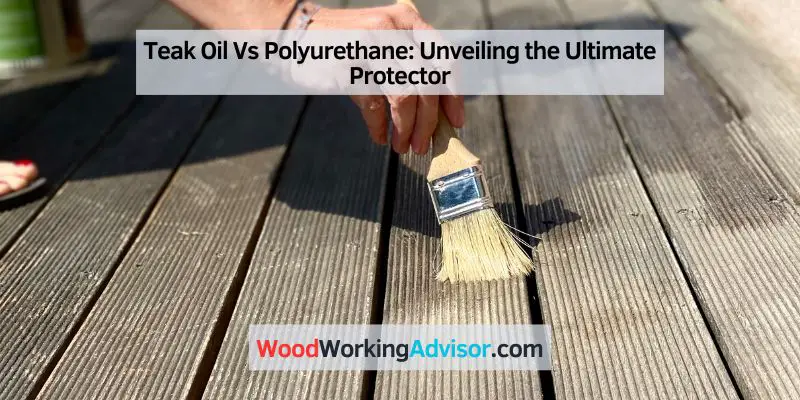Teak oil penetrates the wood, enhancing its natural beauty, while polyurethane forms a protective layer on the surface, providing better durability and resistance to wear and tear. When it comes to choosing between teak oil and polyurethane, there are important factors to consider.
Teak oil is a popular choice for outdoor furniture and decking because it brings out the natural color and grain of the wood, making it look rich and vibrant. It penetrates deep into the wood, providing protection against moisture, mildew, and UV rays.
However, teak oil requires regular maintenance and reapplication to keep the wood looking its best. Polyurethane, on the other hand, forms a hard and protective layer on the wood’s surface, providing excellent resistance to scratches, stains, and water damage. It offers long-lasting durability and can withstand heavy use, making it a popular choice for indoor furniture and flooring. However, polyurethane may alter the natural appearance of the wood, giving it a glossy and plastic-like finish. Ultimately, the choice between teak oil and polyurethane depends on your preferences and the specific application. Whether you prioritize the aesthetic appeal or the durability of the wood will determine which option is best for you.
Teak Oil
When it comes to protecting and enhancing the natural beauty of wood, teak oil is a popular choice among woodworkers and DIY enthusiasts. This traditional finish has been used for centuries on teak furniture and other exterior wood surfaces. In this post, we will explore what teak oil is, its pros and cons, the application process, and maintenance tips.

What Is Teak Oil?
Teak oil is a specifically formulated finish that penetrates into the wood pores, providing nourishment and protection to the surface. It is commonly used on outdoor furniture, boat decks, and other wooden fixtures that are exposed to the elements.
Pros Of Using Teak Oil
Using teak oil has several advantages:
- Enhances natural beauty: Teak oil enhances the natural warm tones and grain patterns of the wood, giving it a rich and lustrous appearance.
- Easy application: Applying teak oil is a simple process that can be done by anyone with basic woodworking skills. It can be brushed or wiped onto the wood surface, allowing for easy penetration.
- Moisture protection: Teak oil creates a protective barrier against moisture, preventing warping, cracking, and rotting of the wood.
- UV resistance: Teak oil contains UV inhibitors that help to prevent the wood from fading and grayish discoloration caused by sun exposure.
- Low maintenance: With regular reapplication, teak oil maintains its protective qualities and keeps the wood looking beautiful for years to come.
Cons Of Using Teak Oil
However, there are a few drawbacks to consider:
- Shorter lifespan: Unlike polyurethane, teak oil does not form a hard, durable coating. This means that it may need to be reapplied more frequently, especially in high-traffic areas.
- Requires regular maintenance: To keep the wood adequately protected, teak oil requires regular reapplication, typically every 6-12 months. Failure to do so can result in reduced protection and deterioration of the wood surface.
- Not suitable for all wood types: Teak oil is specially formulated for dense woods like teak, mahogany, and rosewood. It may not be as effective on softer woods or woods with open pores, as it may not penetrate and provide adequate protection.
- Application can be messy: When applying teak oil, it is important to use absorbent cloths or brushes to ensure even coverage. However, this can sometimes result in a messy application process if not done carefully.
Application Process
Applying teak oil involves the following steps:
- Clean the wood surface to remove any dirt or debris.
- Apply the teak oil using a brush or cloth, following the direction of the wood grain.
- Allow the oil to penetrate for about 15-30 minutes.
- Wipe off any excess oil with a clean, lint-free cloth.
- Let the oil dry completely before using or applying additional coats.
Maintenance And Reapplication
To ensure the longevity and effectiveness of teak oil, regular maintenance and reapplication are key. Here are some tips:
- Inspect the wood surface regularly for signs of wear or deterioration.
- Clean the surface with a mild soap and water solution before reapplying teak oil.
- Apply a fresh coat of teak oil every 6-12 months or as needed.
- Before reapplication, sand the wood lightly to remove any flaking or loose oil.
- Ensure the wood is completely dry before applying the new coat of teak oil.
Polyurethane
In the world of wood finishing, polyurethane is often considered as a top choice due to its durability and protective qualities. Unlike teak oil, which is absorbed into the wood, polyurethane forms a hard, protective layer on the surface of the wood. This layer acts as a barrier against moisture, scratches, and other potential damage, making polyurethane an excellent option for projects that require maximum protection and longevity.
What Is Polyurethane?
Polyurethane is a type of varnish commonly used for finishing wood surfaces. It is a synthetic resin that is created by combining various chemical compounds. When applied to wood, polyurethane dries to form a hard, clear, and glossy finish that enhances the natural beauty of the grain while providing excellent protection.
Pros Of Using Polyurethane
Choosing polyurethane as your wood finish offers several advantages:
- Durability: Polyurethane creates a tough protective layer that is resistant to scratches, stains, and water damage.
- Longevity: With its strong resistance to wear and tear, polyurethane provides long-lasting protection to your wood surfaces.
- Enhanced appearance: The glossy finish of polyurethane enhances the natural beauty of the wood, highlighting its grains and colors.
- Easy to clean: Polyurethane is relatively easy to clean, requiring only a mild soap and water solution to remove dirt and debris.
Cons Of Using Polyurethane
While polyurethane has numerous benefits, it does have a few drawbacks that should be considered:
- Application challenges: Applying polyurethane can be more difficult than applying teak oil. It requires careful attention to detail to avoid streaking or bubbling.
- Strong odor: Polyurethane has a strong chemical smell that can linger for several days after application, which may be unpleasant for some individuals.
- Environmental impact: Some polyurethane products contain volatile organic compounds (VOCs) that can contribute to air pollution and potential health risks.
- Less natural look: The glossy finish of polyurethane may not be desirable for those who prefer a more natural appearance for their wood surfaces.
Application Process
The application process for polyurethane involves several steps:
- Preparation: Ensure that the wood surface is clean, smooth, and free from any dirt, dust, or previous finish. Sanding may be required to achieve a smooth base.
- Application: Using a high-quality brush or a foam applicator, apply a thin and even coat of polyurethane onto the wood surface. Allow it to dry according to the manufacturer’s instructions.
- Sanding and additional coats: After the initial coat has dried, lightly sand the surface with fine-grit sandpaper to remove any imperfections. Apply additional coats of polyurethane, repeating the sanding process between each coat for a smooth and flawless finish.
- Drying and curing: Allow the final coat of polyurethane to dry and cure completely before subjecting the wood surfaces to any heavy use or contact.
Maintenance And Reapplication
Maintaining polyurethane-finished wood surfaces is relatively simple:
- Regular cleaning: Remove dust and dirt using a soft cloth or a vacuum cleaner with a brush attachment. Avoid using abrasive cleaners or harsh chemicals that can damage the polyurethane finish.
- Preventing scratches: Use coasters, placemats, and protective pads to prevent scratches from items such as hot dishes, sharp objects, and heavy furniture.
- Reapplication: Over time, the polyurethane finish may wear off or become dull. When this happens, lightly sand the surface and apply a fresh coat of polyurethane to restore the protective layer and revive the appearance of the wood.

Comparison
When it comes to protecting and enhancing the beauty of wooden furniture or surfaces, two popular options are teak oil and polyurethane. Both offer unique features and advantages, making it essential to understand their differences before deciding which one suits your needs best. In this comparison, we will explore the key factors that differentiate these two finishes: durability and protection, appearance and finish, ease of application, maintenance requirements, environmental factors, and cost considerations.
Durability And Protection
When it comes to durability and long-term protection, polyurethane takes the lead. This synthetic finish forms a hard, plastic-like coating that provides superior resistance against scratches, water damage, UV rays, and general wear and tear. On the other hand, teak oil penetrates the wood, enhancing its natural beauty without creating a thick barrier. While teak oil offers decent protection against moisture and mildew, it may require frequent reapplication to maintain its effectiveness.
Appearance And Finish
If enhancing the natural beauty and grain of the wood is your primary concern, teak oil is the superior choice. It enhances the warm, rich tones of the wood, giving it a natural, satin-like finish. Conversely, polyurethane tends to create a glossy and more uniform appearance, concealing some of the wood’s natural characteristics. The choice between these two finishes depends on your desired aesthetic and the level of sheen you prefer for your wood surfaces.
Ease Of Application
When it comes to ease of application, teak oil takes the lead. It can be easily applied using a brush or cloth, allowing you to achieve even coverage without much effort. On the other hand, polyurethane requires a bit more skill and experience to apply evenly without leaving brush marks or bubbles. Additionally, polyurethane often requires sanding between coats to achieve a smooth finish, adding extra time and labor to the application process.
Maintenance Requirements
In terms of maintenance, both teak oil and polyurethane have their distinct requirements. Teak oil, although easy to apply, generally needs to be reapplied every few months or annually to maintain its protective properties. It may also require periodic sanding to remove any surface imperfections. On the other hand, polyurethane provides a more durable and long-lasting finish, requiring minimal maintenance. Regular cleaning with a mild soap solution is usually sufficient to keep polyurethane-protected surfaces looking their best.
Environmental Factors
For those with a concern for the environment, teak oil may be a more preferable option. Teak oil is typically made from natural oils, making it a more eco-friendly choice compared to polyurethane, which is a synthetic product containing various chemicals. However, it’s worth noting that both finishes release volatile organic compounds (VOCs) during application and curing, so it’s important to ensure proper ventilation and follow manufacturer guidelines to minimize any negative environmental impact.
Cost Considerations
When it comes to cost, teak oil is generally more affordable than polyurethane. Teak oil is readily available and comes in various price ranges, making it accessible to most budgets. Polyurethane, on the other hand, tends to be slightly more expensive, especially if you opt for high-quality brands or specialized formulations. However, considering the longer life span and lower maintenance requirements, polyurethane may offer better value for money in the long run.
Frequently Asked Questions Of Teak Oil Vs Polyurethane
What Is Teak Oil Used For?
Teak oil is used to protect and enhance the natural beauty of teak wood. It provides a rich, warm finish and helps to prevent the wood from drying out, cracking, and fading due to exposure to the elements.
What Is Polyurethane Used For?
Polyurethane is used as a protective coating for various surfaces such as wood, metal, and concrete. It provides resistance against scratches, stains, and water damage, making it an ideal choice for finishing furniture, floors, and other objects that require durability.
What Are The Advantages Of Teak Oil?
Teak oil deeply penetrates the wood, preserving its natural color and grain. It enhances the wood’s beauty, protects it from UV rays and moisture, and is easy to apply and maintain. Teak oil also provides a warm and natural finish that adds a touch of elegance to any furniture piece.
What Are The Advantages Of Polyurethane?
Polyurethane offers excellent protection against wear and tear, making it suitable for high-traffic areas. It is highly durable, water-resistant, and can withstand extreme temperatures and chemicals. Polyurethane also provides a beautiful glossy or satin finish that enhances the appearance of any surface.
Conclusion
After weighing the pros and cons of Teak Oil and Polyurethane, it is clear that both have their advantages and disadvantages. Teak Oil offers a natural, warm finish that enhances the beauty of wood, while Polyurethane provides a durable, protective layer.
Ultimately, the choice depends on personal preference, desired aesthetic, and level of maintenance. Consider the specific needs of your project before making a decision. Choose wisely and enjoy the stunning results!



One thought on “Teak Oil Vs Polyurethane: Unveiling the Ultimate Protector”